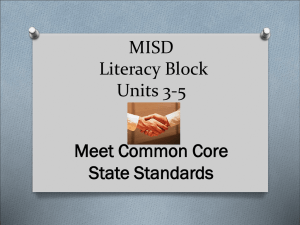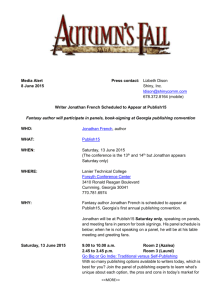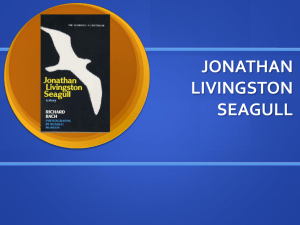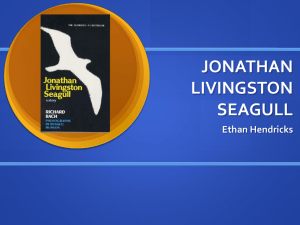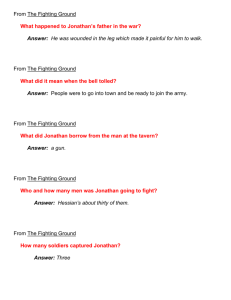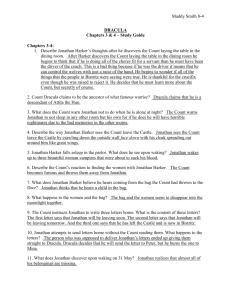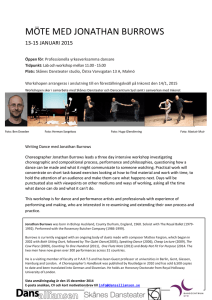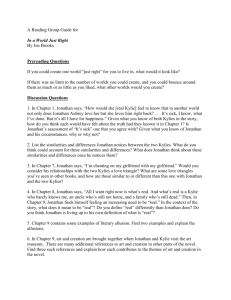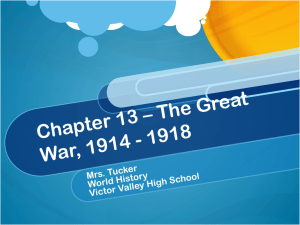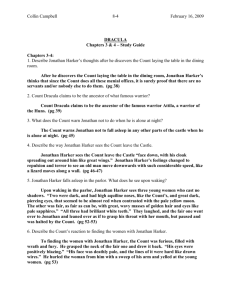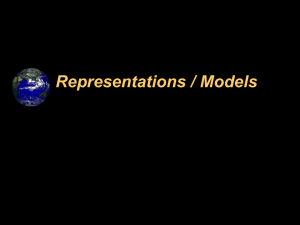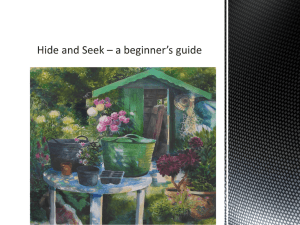MISD Literacy Block Units
advertisement
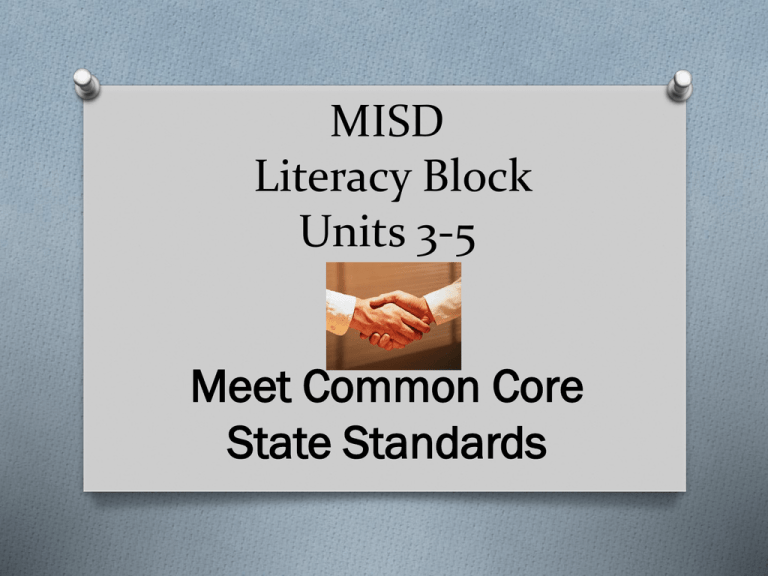
MISD Literacy Block Units 3-5 Meet Common Core State Standards Units Meet Common Core Reading Anchor Standards O Read Aloud correlates with Standards 2, 3, 4, 5, 6, 8, and 9. O Shared Reading correlates with Standards 2, 3, 4, 5, 6, 7, 8, and 9. O Guided Reading correlates with Standards 1, 2, 3, 4, 5, 6, 7, 8, and 9. O Independent Reading correlates Standards 1, 2, 3, 4, 5, 6, 7, 8, 9, and 10. O Strategies That Work correlates with Standards 1, 2, 3, 4, 5, 6, 7, 8, 9, and 10. O GHR for Summary/Multiple-Choice/Craft correlates with Standards 1, 2, 3, 4, 5, and 6. O Writing: Thematic Prompts/Quick Writes correlate with Standards 1, 2, 3, 4, 5, 6, 7, 9, 10. O Focus Questions correlate with Standards 1, 2, 3, 4, 6, 8, and 10. O Vocabulary in Context correlates with Standards 4 and 10. O Fluency correlates with Standards 4 and 10. O Research correlates with Standards 7 and 10. 1754-1763 Background Information for Review The French and Indian War The Sign of the Beaver takes place in 1768 after the war. 1770 March 5 The Boston Massacre Protesting colonists throwing snowballs and sticks killed by British 1773 D e c. 1 6 The Boston Tea Party protesters of the tea tax tossed 342 chests of tea into the water 1775 Apr. 18 Apr. 19 The Rides of Paul Revere and William Dawes warning colonists the British were coming Battles of Lexington and Concord American and British Accounts of Battle of Concord 1776 July 4 Dec. 26 Congress adopts the Declaration of Independence; it's sent to the printer Washington crosses the Delaware and captures Trenton from Hessians The Fighting Ground 1777 Jan. 3 Oct. 22 Washington victorious at Princeton The Fighting Ground takes place in New Jersey Hessian attack on Fort Mercer, NJ repulsed The Fighting Ground takes place in New Jersey 1778 Feb. 6 The United States and France sign French Alliance The Fighting Ground takes place on 4/3/1778. Reading Literature balanced with related Informational Text Plus Primary Source Selections O “Emerson Describes the Stand at Concord Bridge” Describes the battle from an American colonist’s viewpoint. (a famous author) O “British Account of the Battle at Concord Bridge” Describes the battle from a British soldier’s viewpoint. Guided Highlighted Reading OPrompts OMultiple-Choice OSummary From Guided Highlighted Reading: A Close-Reading Strategy for Navigating Complex Text, Weber, Nelson, and Schofield, 2011, Maupin House. Guided Highlighted Reading: O is text-driven and meaning-based O focuses students on the content of text O guides students to read for one reading purpose at a O O O O O time invites and guides students to revisit the text more than once guides students to return to the same text for multiple purposes targets the acquisition of skills needed for close and critical reading builds fluency and stamina in readers uses multiple senses: visual, auditory, and kinesthetic From Guided Highlighted Reading: A Close-Reading Strategy for Navigating Complex Text, Weber, Nelson, and Schofield, 2011, Maupin House. Explanatory Prompt Based on the excerpt from The Fighting Ground, predict what will happen next in the novel. Explain what will happen if Jonathan decides to go off to war. Give evidence and details from the two accounts of the Battle of Concord Bridge to support your explanation of what going to war might be like for Jonathan. Scaffolding Think about the following as you plan, write, and revise: O Begin by explaining why Jonathan decides to go off to war using information from the excerpt from The Fighting Ground. O Explain what will probably happen next using evidence from the two accounts of the Battle of Concord Bridge. O Conclude by predicting what will happen to Jonathan and why you think it will happen. Scaffolding: Graphic Organizer Explanatory writing looks at a topic—Jonathan’s dream—and explains what it might be like in reality. Introduction: Let your readers know your topic (Jonathan will go to war) and briefly mention what war might be like using information from the two accounts of a battle. Development: Give evidence from The Fighting Ground to prove that Jonathan wants to go to war. Give evidence from the two accounts of the battle to show what Jonathan might experience. Conclusion: End by briefly summarizing your important points and evidence. Revising/Proofreading Sharing with Data Walls O Groups of four O Data Walls for supporting examples O Students individually make a list. O Group list on Post-it notes O Students place their Post-it notes. O Teacher shares Preparing for Reading O Vocabulary before, during, or after O Focus for Reading/Listening O “Walk Through” Book Features O Genre Defined Vocabulary In this instance, read the excerpt aloud to students while they follow along on their numbered copies. (See Appendix 1f.) Then read the prompts and have students highlight as directed. Because this is primary source material, you will need to explain the following vocabulary: celerity (“speed”), prudent (“careful”), fickleness (“indecisiveness”), and quitted (“left”). Focus for Reading/Listening Focus for Listening: What does Jonathan decide to do? (He decides to go with the Corporal. How does he get the tavern owner to lend him a gun? (He misquotes his father.) How does the length of the gun compare to Jonathan’s height? (The gun is longer that he is tall.) What do the other men seem to be concerned about? (More men are needed.) Scaffolding for Guided Reading and Discussion Guided Reading (If students are having problems, do Shared Reading or Read Aloud. Point out some or all of the problems and questions Jonathan and the men have: O Pp.19-20: The gun, cartridge box, and powder horn are making it O O O O difficult for Jonathan to travel. Pp. 20-22: The men have questions about the number of enemy soldiers they will be fighting and how they will fight. They seem to prefer ambush. (p. 22) Pp. 22-24: Jonathan’s father’s friend does not seem to have answers. Jonathan decides to lie to him about his father’s permission. Pp. 24-27: The weather is hotter, the men are tired, and the men are still questioning the Corporal—now about where the other soldiers are. One man challenges the Corporal for being “…overfond of killing.” (p. 27) Pp. 28-31: Jonathan wonders when they will get to the fighting ground. The men encounter a woman who gives them water and is then frightened by their report. One soldier shoots his gun; nobody approves. Discussion and Review O Focus for Reading (parenthesis) O Guided Reading (notes) O Focus Questions Focus Question #5 Consider the decisions/choices Jonathan makes (not to shoot the soldiers, to try to escape with the boy, and to leave the gun behind). Are these good choices? Why or why not? Possible Answer: O If he shoots the soldiers while they are sleeping, he is just as O O O O O much of a murderer as the person who killed the boy's parents in cold blood. If he doesn't shoot them, he may die himself because they will kill him. If he tries to escape with the boy, and the soldiers see them, they will probably both be killed. If he doesn't try to escape with the boy, they could both be murdered in cold blood the way the boy's parents were. If he takes the gun, travel to escape will be much slower, because he will not be able to carry the boy. If he doesn't take the gun, he will not be able to defend himself or the boy. Research Research Opportunities Loading and Firing a Flintlock O Place the rifle on "half cock" (Safety) and open the pan by pushing the "frizzen" forward. O Reach into the cartridge box and grab a single cartridge. (These are twisted paper tubes with enough powder and ball for one shot.) O Bite the cartridge open. O Prime. (Place some powder in the pan of the lock.) Close the frizzen. Leave the rifle at half cock. O Charge with powder. (Pour the remaining powder down the muzzle of the barrel.) Then insert the paper-wrapped ball. This ball was NOT patched for speed in loading. O Draw the rammer. (Pull the ramrod from the stock.) O Ram. Push the ball and paper ALL THE WAY DOWN until it is resting firmly on top of the powder. O Return the rammer. (Replace the rod in the stock.) O The rifle is now LOADED. HANDLE IT WITH THE CARE DUE A LOADED WEAPON. (elapsed time: 15 seconds) O Make ready. (Bring the hammer to "full cock.") O Fire. (Squeeze trigger.) http://www.youtube.com/watch?v=zpzIb3XjyyY&feature=related Writing O Common Core Genres O Reading/Writing Thematic Prompts O Focus Questions O Quick Writes Reading/Writing Thematic Prompts Coming of Age O Matt from Sign of the Beaver O Jonathan from The Fighting Ground Reading/Writing Prompt Both The Sign of the Beaver and The Fighting Ground are coming-ofage novels because the two main characters have grown up into responsible men over the course of the book. In coming-of-age novels, the main characters learn to take responsibility for their decisions and their actions. Matt from The Sign of the Beaver has to survive over four months alone in the wilderness while he waits for his family. Jonathan, who has dreamed of the glory of being a soldier, learns through experience in just one day that war is not so glorious and that he should be at home where he is needed. Writing Prompt Explain what coming of age means as it applies to Matt in The Sign of the Beaver and Jonathan in The Fighting Ground. Use evidence, details, and quotations from the two novels, especially the two excerpts you have just read, to support your explanation. Graphic Organizer Example Development: O Give evidence (SBAC) that Jonathan has come of age over the course of The Fighting Ground. O Give evidence that Matt has come of age over the course of The Sign of the Beaver. Writing Prompts O Explanations and ideas O Checklist (CCSS) O Writing Process O Graphic Organizer O Peer Editing Questions Speaking and Listening O Come to discussions prepared, having read or studied required material; explicitly draw on that preparation and other information known about the topic to explore ideas under discussion. O Follow agreed-upon rules for discussions (e.g., gaining the floor in respectful ways, listening to others with care, speaking one at a time about the topics and texts under discussion). O Ask questions to check understanding of information presented, stay on topic, and link their comments to the remarks of others. O Explain their own ideas and understanding in light of the discussion. Speaking and Listening Choral Reading The Declaration of Independence Thank You! Advisory Team Original Authors O O O O O O O O O O O O Clare Baxter 3rd Roseville Diana Ronayne 3rd Mount Clemens Linda Pelloni 3rd Lakeview Sue Francek 3rd Roseville Marcia Powell 4th Van Dyke Mary Dombro 4th Anchor Bay Renee Fiema 4th L’Anse Creuse Sandy Hudkins 4th Van Dyke Cathy Walle 5th Consultant Dave Figurski 5th Warren Debbie Parrish 5th Fraser Jackie Rybinski 5th Warren O O O O O O O O O O O O Clare Baxter, Consultant Diane Berg, Consultant Virginia Daniels, Fraser Betsy Facione, Utica Mary Kate Fitzpatrick, Fraser Theresa Hasenauer, Utica Melissa Labadie, Utica Stephanie La Belle, Van Dyke Kathy Ming, Consultant Debbie Parrish, Consultant Sharon Rice, Van Dyke Elaine Weber, MISD Thank You! MISD for encouragement and support and Dr. Lisa Rivard, Project Director
